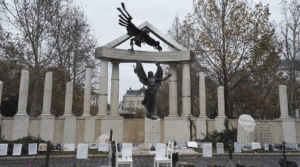
Monuments function to memorialize historical events or figures, encourage certain values, and shape collective identity. But what happens when physical representations of the past do not fully reflect truth?
The term ‘memory politics’ encapsulates the process through which a society develops its collective understanding of historical events. Memory politics studies the impact the agenda of the powerful has on how history is perceived by the general populace, and therefore how social, political, and cultural systems function. Within the complexity of memory politics, however, there needs to be room for community revision and pushback to harmful narratives.
In 2014, with no prior notice or public input, a monument called Német Megszállás Áldozatainak (Memorial for the Victims of the German Occupation) was built in Liberty Square in Budapest, Hungary. The monument consists of the archangel Gabriel (supposed to represent Hungary) being attacked by an eagle (meant to embody Nazi Germany) and has a plaque that says “In memory of the victims.”

The memorial quickly sparked backlash because of its portrayal of Hungary as a helpless victim to German aggression when in reality, Hungary was complicit and even cooperative in Nazi Germany’s discrimination towards and persecution of Jewish people (and other targeted minority groups) during the Holocaust. After Nazi Germany occupied Hungary in March 1944, mass deportations took place from May to July of that same year. Over that period of time, an estimated 440,000 Jewish people were deported from Hungary, most of whom were sent to Auschwitz-Birkenau concentration camp and killed upon arrival in gas chambers.
The monument lacks specific mention of Jewish Hungarians at all. The situation was even more contentious given the context of Viktor Orbán’s government’s desire to push a narrative of historical suffering that focused more on the Hungarian victims of Communism than the Hungarian Jewish victims of the Holocaust. This same criticism has also been leveled against the popular Budapest museum Terror Háza (House of Terror), displaying a pattern of manipulation of memory.
When faced with a concerted effort to deflect responsibility for the horrors perpetrated by the Hungarian government against its own Jewish citizens, members of the local community created a counter-memorial to honor Hungarian Holocaust victims. Maintained by volunteers and family members, the counter-memorial is made up of photographs, names, and personal items of people who died in Nazi concentration camps. The purpose of this living counter-memorial is to thoughtfully challenge the problematic narrative presented by the monument. The counter-memorial elicits a powerful emotional response of grief and devastation. By paying tribute to specific Jewish and Roma men, women, and children who were discriminated against and brutally killed by the Nazi regime, this counter-memorial confronts attempted distortion of history by the Hungarian government and urges the public and visitors to remember truthfully and grapple with difficult aspects of Hungary’s past.


